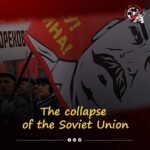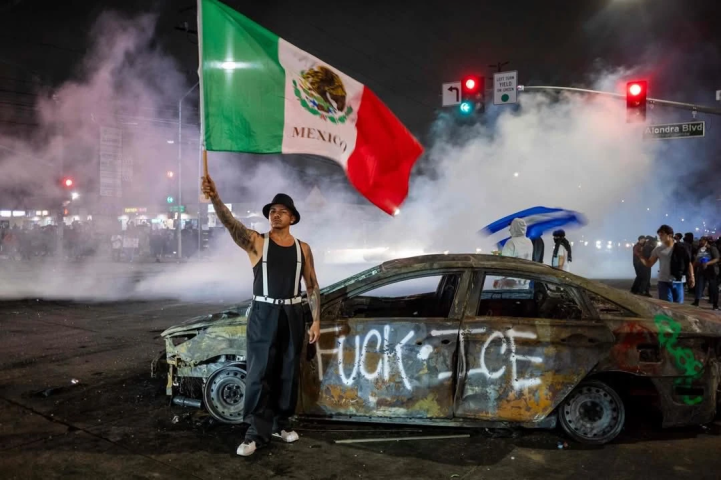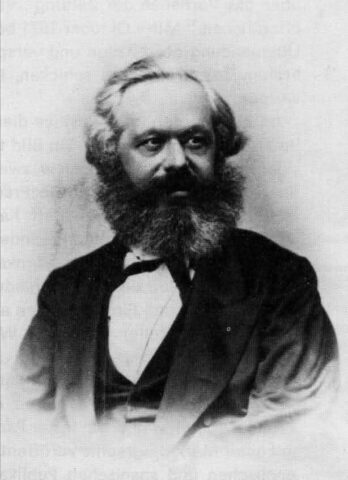Raju Prabath Lankaloka
This month marks the 31st anniversary of the collapse of the Soviet Union. The most powerful deformed workers’ state was collapsing into chaos as supposed communists were looting the state and its assets, cheered on by the imperialists of the west. Capitalism reared its ugly head, and the workers of the Soviet Union had to pay the price.
The collapse of the USSR was presented by the defenders of capitalism as the equivalent of the final victory of the “free market economy” over “Communism”. Three decades ago, it produced a wave of euphoria in the bourgeoisie and its apologists. They spoke of the end of socialism, the end of communism and even the end of history and ever since then we have witnessed an unprecedented ideological offensive against the ideas of Marxism on a world scale. This irrational exuberance knew no bounds.
Three decades later, not one stone upon other remains of these foolish illusions. Capitalism has entered into the most serious crisis since the Great Depression. Millions are faced with a future of unemployment, poverty, cuts and austerity. Wars, conflicts and pandemics ravage the entire planet, the very future of which is placed in jeopardy by the depredations wreaked by the uncontrolled market economy. The global crisis of capitalism and its effects have falsified those confident predictions. All the lavish promises of milk and honey by the Western leaders that followed the collapse of the Soviet Union have evaporated like a drop of water on a hot stove.
October Revolution
The Russian Revolution of 1917 was the greatest event in human history. For the first time in history, the oppressed didn’t just rise up, but they rose up, took power and held on to it. Even the combined forces of all the world’s imperialist nations failed to dislodge the new workers’ state.
The October revolution of 1917 brought about the greatest advance of the productive forces of any country in history. In a period of 50 years, the USSR increased its gross domestic product nine times over. Despite the terrible destruction of the Second World War, it increased its GDP five times over from 1945 to 1979. In 1950, the GDP of the USSR was only 33 per cent that of the USA. By 1979, it was already 58 per cent. By the late 1970s, the Soviet Union was a formidable industrial power, which in absolute terms had already overtaken the rest of the world in a whole series of key sectors. The USSR was the world’s second biggest industrial producer after the USA and was the biggest producer of oil, steel, cement, asbestos, tractors, and many machine tools.
What went wrong
The achievements of Soviet industry, science and technology have already been explained. But there was another side to the picture. The democratic workers’ state established by Lenin and Trotsky was replaced by the monstrously deformed bureaucratic state of Stalin. This was a terrible regression, signifying the liquidation of the political power of the working class, but not of the fundamental socio-economic conquests of October
In the 1920s Trotsky wrote a small book with the title: Towards socialism or capitalism? That was always the decisive question for the USSR. The official propaganda was that the Soviet Union was moving inexorably towards the achievement of socialism. In the 1960s Khrushchev boasted that socialism had already been achieved and the USSR was going to build a fully communist society in twenty years. But the truth was that the Soviet Union was moving in another direction altogether.
The movement towards socialism should signify a gradual reduction in inequality. But in the Soviet Union inequality continually increased. An abysm opened up between the masses and the millions of privileged officials and their wives and children with their smart clothes, big cars, comfortable apartments and dachas. The contradiction was still more glaring because it contrasted with the official propaganda about socialism and communism.
From the standpoint of the masses, economic success cannot be reduced to the amount of steel, cement or electricity produced. Living standards depend above all on the production of commodities that are of good quality, cheap and easily available: clothes, shoes, food, washing machines, televisions and the like. But in those fields the USSR lagged far behind the West. That would not have been so serious but for the fact that some people enjoyed access to these things while most did not.
The reason why Stalinism could last so long despite all the crying contradictions it created was precisely the act that for decades the nationalised planned economy made extraordinary strides forward. But the suffocating rule of the bureaucracy resulted in corruption, mismanagement, bungling and waste on a colossal scale. It undermined the gains of the planned economy. To the degree that of the USSR developed to a higher level, the negative effects of bureaucracy had even more damaging consequences.
The bureaucracy always acted as a brake on the development of the productive forces. But whereas the task of building up heavy industry was relatively simple, a modern sophisticated economy with its complex relations between heavy and light industry, science and technology cannot be run by bureaucratic fiat without causing the most serious disruption. The costs of maintaining high levels of military expenditure and the costs of maintaining its grip on Eastern Europe imposed further strains on the Soviet economy.
With all the colossal resources at its disposal, the powerful industrial base and the army of high-class technicians and scientists, the bureaucracy was unable to achieve the same results as the West. In the vital fields of productivity and living standards the Soviet Union lagged behind. The main reason was the colossal burden imposed on the Soviet economy by the bureaucracy – the millions of greedy and corrupt officials that were running the Soviet Union without any control on the part of the working class.
As a result, the Soviet Union was falling behind the West. As long as the productive forces in the USSR continued to develop, the pro-capitalist tendency was insignificant. But the impasse of Stalinism transformed the situation completely. By the mid-1960s, the system of bureaucratically controlled planned economy reached its limits. This was graphically expressed by a sharp fall in the rate of growth in the USSR, which declined continually throughout the 1970s, approaching zero under Brezhnev. Once the Soviet Union was not able to obtain better results than capitalism, its fate was sealed.
Once this stage had been reached, the bureaucracy ceased to play even the relatively progressive role it had played in the past. This is the reason why the Soviet regime entered into crisis.
The political counter-revolution carried out by the Stalinist bureaucracy in Russia completely liquidated the regime of workers’ Soviet democracy, but did not destroy the new property relations established by the October Revolution. The ruling bureaucracy based itself on the nationalised, planned economy and played a relatively progressive role in developing the productive forces, although at three times the cost of capitalism, with tremendous waste, corruption and mismanagement, as Trotsky pointed out even before the war when the economy was advancing at 20 per cent a year.
But despite its successes, Stalinism did not solve the problems of society. The nationalised planned economy was in contradiction to the bureaucratic state. Even in the period of the first Five-Year Plans, the bureaucratic regime was responsible for colossal waste. This contradiction did not disappear with the development of the economy, but, on the contrary, grew ever more unbearable until eventually the system broke down completely.
Trotsky’s analysis
Leon Trotsky, the great Russian Marxist understood that the fate of the Soviet Union would be determined by the struggle of living forces, which was in turn inseparably connected with developments on a world scale: such developments could not be precisely predicted in advance. In fact, the peculiar way in which the Second World War unfolded had a decisive effect on the destiny of the Soviet Union, which was anticipated by nobody. Trotsky wrote:
“It is impossible at present to answer finally and irrevocably the question, in what direction the economic contradictions and social antagonisms of Soviet society will develop, in the course of the next three, five or ten years. The outcome depends upon a struggle of living social forces—not on a national scale, either, but on an international scale. At every new stage, therefore, a concrete analysis is necessary of actual relations and tendencies in their connection and continual interaction.” (Trotsky, The Revolution Betrayed, p. 49)
Trotsky was careful to place a question mark over the future of the Soviet state. His prediction that the Stalinist bureaucracy in order to preserve their privileges “must inevitably in future stages seek support for itself in [capitalist] property relations”, was shown to be absolutely correct. The disgusting spectacle of long-standing Communist Party leaders, managers and officials tearing up their Party cards and openly transforming themselves into “entrepreneurs”, with the same ease as a man moving from one compartment on a train to another, shows how far the Stalinist regime was from genuine socialism.
Trotsky did not expect the Stalinist regime to last as long as it did. True, in his last work Stalin, he did suggest that the regime might last for decades in its present form, but the book was unfinished at the time of his assassination, and he was unable to develop this idea further. The Soviet Union emerged from the Second World War enormously strengthened. The Stalinist regime, which Trotsky regarded as a temporarily historical aberration, survived for decades. This had a profound effect on everything, particularly the consciousness of the masses and the bureaucracy itself.
Trotsky had hoped that the Stalinist regime would be overthrown by a political revolution of the working class. But if that did not happen, he raised the possibility at a certain stage that the process of bureaucratic counter-revolution would lead to the overthrow of the property relations established by the October Revolution:
The perspective of capitalist restoration in Russia and its repercussions was explained with remarkable foresight by Trotsky In 1936:
“A collapse of the Soviet regime would lead inevitably to the collapse of the planned economy, and thus the abolition of state property. The bond of compulsion between the trusts and the factories within them would fall away. The more successful enterprises would succeed in coming out on the road of independence. They might convert themselves into stock companies, or they might find some other transitional form of property—one, for example, in which the workers should participate in the profits. The collective farms would disintegrate at the same time and far more easily. The fall of the present bureaucratic dictatorship, if it were not replaced by a new socialist power, would thus mean a return to capitalist relations with a catastrophic decline of industry and culture.” (Leon Trotsky, The Revolution Betrayed, pp. 250-1)
What strikes one is the brilliant way in which Trotsky anticipated the main lines of what actually took place in Russia. After the Second World War Ted Grant developed and extended Trotsky’s analysis of proletarian Bonapartism, particularly in The Marxist Theory of the State, which comprehensively demolished the idea of state capitalism in Russia.
The crisis of Stalinism had nothing whatsoever in common with the crisis of capitalism (or “state capitalism”). The latter is the result of the anarchy of the market and private ownership. But there was no question of a crisis of overproduction in the case of the USSR, which was based on a nationalised planned economy, although one afflicted with all the evils of bureaucracy, corruption and mismanagement.
To this must be added the limiting character of the nation state, which has outlived its usefulness and become a gigantic fetter on the productive forces. This explains why every country, even the biggest superpower, is compelled to participate on the world market. This was predicted in advance by Marx. It is also the reason why the idea of socialism in one country is a reactionary utopia.
What failed in Russia was not communism or socialism
What failed in Russia and Eastern Europe was not communism or socialism, in any sense that this was understood by Marx or Lenin, but a bureaucratic and totalitarian caricature. Lenin explained that the movement towards socialism requires the democratic control of industry, society and the state by the proletariat. Genuine socialism is incompatible with the rule of a privileged bureaucratic elite, which will inevitably be accompanied by colossal corruption, nepotism, waste, mismanagement and chaos.
The enemies of socialism will reply scornfully that the experiment ended in failure. We reply in the words of that great philosopher Spinoza that our task is neither to weep nor to laugh but to understand. But one would look in vain in all the writings of the bourgeois enemies of socialism to find any serious explanation for what occurred in the Soviet Union. Their so-called analyses lack any scientific basis because they are motivated by blind hatred that reflects definite class interests.
The movement towards capitalism has meant a big step backwards for the people of Russia and the former Republics of the USSR. Society was thrown back and had to learn all the blessings of capitalist civilization: religion, prostitution, drugs, and all the other “blessings” of capitalism.
The Achilles heel of Russian capitalism is that it is now linked with an umbilical cord to the fate of world capitalism. It is subject to all the storms and stresses of a system that finds itself in a terminal crisis. This will have a profound impact on Russia, both economically and politically. Sooner or later the Russian workers will recover from the effects of the defeat and move into action. When that happens they will quickly rediscover the traditions of the October revolution and the ideas of genuine Bolshevism. That is the only way forward for the workers of Russia and the entire world.
![]()




